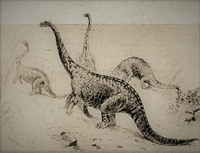
Photo from wikipedia
Partial rbcL sequences from type specimens of three of the earliest described Corallina species showed that C. arbuscula (type locality: Unalaska Island, Alaska, USA) and C. pilulifera (type locality: Okhotsk… Click to show full abstract
Partial rbcL sequences from type specimens of three of the earliest described Corallina species showed that C. arbuscula (type locality: Unalaska Island, Alaska, USA) and C. pilulifera (type locality: Okhotsk Sea, Russia) are synonymous, with C. pilulifera as the taxonomically accepted name and that C. vancouveriensis (type locality: Botanical Beach, Vancouver Island, Canada) is a distinct species. To identify molecular species limits and clarify descriptions and distributions of C. pilulifera and C. vancouveriensis, we sequenced and analyzed portions of one mitochondrial and two plastid genes from historical and recent collections. The single‐gene phylogenetic reconstructions support the recognition of both species as distinct, as well as two additional species, C. hakodatensis sp. nov. and C. parva sp. nov., which are sister to, and often morphologically indistinguishable from C. pilulifera and C. vancouveriensis, respectively. DNA sequence data currently illustrate that C. pilulifera is found in the cold northern Pacific waters from the Okhotsk Sea of Russia to Hokkaido, Japan, eastward across the Aleutian Islands to Knoll Head, Alaska, and as far south as Nanaimo, British Columbia. Corallina vancouveriensis is distributed as far west as Attu Island in the Aleutian Islands to Sitka, Alaska, and southeasterly at numerous sites from British Columbia to the north of Point Conception, California, USA. The cryptic species C. hakodatensis and C. parva occur sympatrically with their sister species but with narrower ranges. The complex phylogenetic relationships shown by the single gene trees recommend Corallina as a model genus to explore coralline algal biogeography, evolution, and patterns of speciation.
Journal Title: Journal of Phycology
Year Published: 2022
Link to full text (if available)
Share on Social Media: Sign Up to like & get
recommendations!